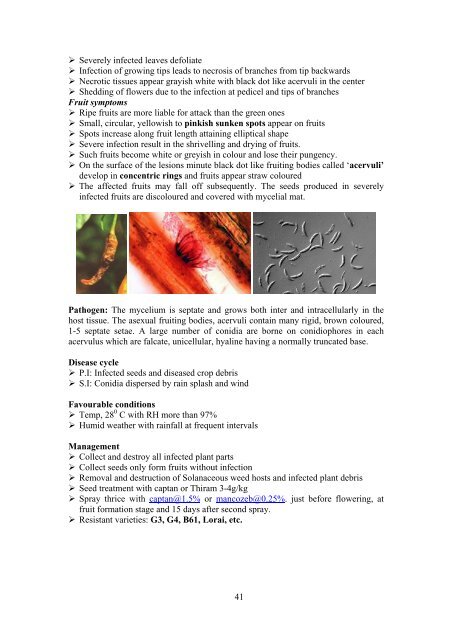PATH 372 Diseases of Horticultural Crops
PATH 372 Diseases of Horticultural Crops
PATH 372 Diseases of Horticultural Crops
You also want an ePaper? Increase the reach of your titles
YUMPU automatically turns print PDFs into web optimized ePapers that Google loves.
Severely infected leaves defoliate<br />
Infection <strong>of</strong> growing tips leads to necrosis <strong>of</strong> branches from tip backwards<br />
Necrotic tissues appear grayish white with black dot like acervuli in the center<br />
Shedding <strong>of</strong> flowers due to the infection at pedicel and tips <strong>of</strong> branches<br />
Fruit symptoms<br />
Ripe fruits are more liable for attack than the green ones<br />
Small, circular, yellowish to pinkish sunken spots appear on fruits<br />
Spots increase along fruit length attaining elliptical shape<br />
Severe infection result in the shrivelling and drying <strong>of</strong> fruits.<br />
Such fruits become white or greyish in colour and lose their pungency.<br />
On the surface <strong>of</strong> the lesions minute black dot like fruiting bodies called ‘acervuli’<br />
develop in concentric rings and fruits appear straw coloured<br />
The affected fruits may fall <strong>of</strong>f subsequently. The seeds produced in severely<br />
infected fruits are discoloured and covered with mycelial mat.<br />
Pathogen: The mycelium is septate and grows both inter and intracellularly in the<br />
host tissue. The asexual fruiting bodies, acervuli contain many rigid, brown coloured,<br />
1-5 septate setae. A large number <strong>of</strong> conidia are borne on conidiophores in each<br />
acervulus which are falcate, unicellular, hyaline having a normally truncated base.<br />
Disease cycle<br />
P.I: Infected seeds and diseased crop debris<br />
S.I: Conidia dispersed by rain splash and wind<br />
Favourable conditions<br />
Temp, 28 0 C with RH more than 97%<br />
Humid weather with rainfall at frequent intervals<br />
Management<br />
Collect and destroy all infected plant parts<br />
Collect seeds only form fruits without infection<br />
Removal and destruction <strong>of</strong> Solanaceous weed hosts and infected plant debris<br />
Seed treatment with captan or Thiram 3-4g/kg<br />
Spray thrice with captan@1.5% or mancozeb@0.25%. just before flowering, at<br />
fruit formation stage and 15 days after second spray.<br />
Resistant varieties: G3, G4, B61, Lorai, etc.<br />
41

















